sensor HONDA ACCORD COUPE 2001 CF / 6.G Owners Manual
[x] Cancel search | Manufacturer: HONDA, Model Year: 2001, Model line: ACCORD COUPE, Model: HONDA ACCORD COUPE 2001 CF / 6.GPages: 372, PDF Size: 6.1 MB
Page 46 of 372
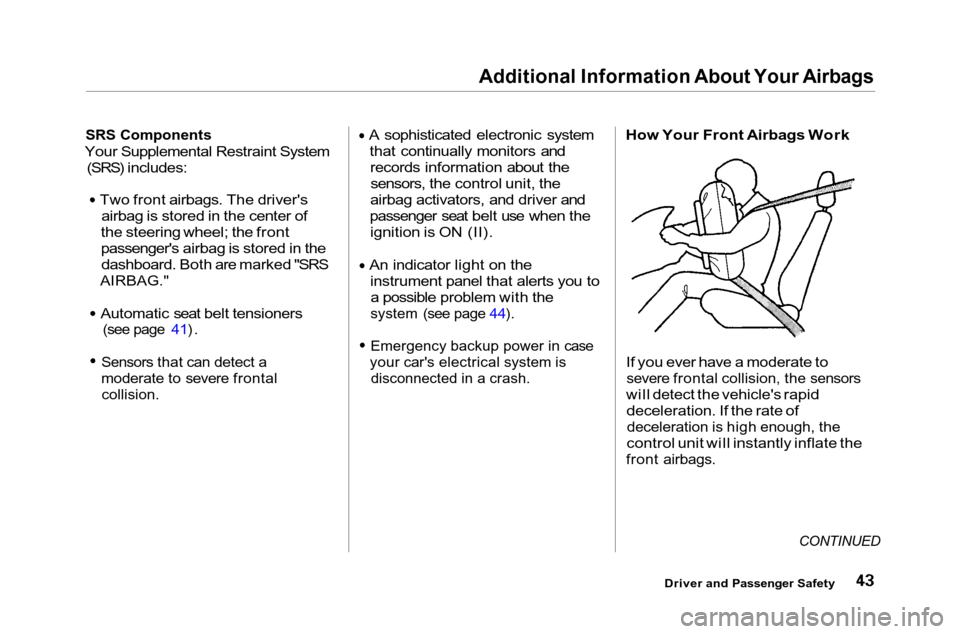
Additional Information About Your Airbags
SRS Components
Your Supplemental Restraint System (SRS) includes:
Two front airbags. The driver'sairbag is stored in the center of
the steering wheel; the front
passenger's airbag is stored in the dashboard. Both are marked "SRS
AIRBAG."
Automatic seat belt tensioners
(see page 41).
Sensors that can detect a
moderate to severe frontal
collision.
A sophisticated electronic system
that continually monitors andrecords information about thesensors, the control unit, the
airbag activators, and driver and
passenger seat belt use when the ignition is ON (II).
An indicator light on the instrument panel that alerts you toa possible problem with the
system (see page 44).
Emergency backup power in case
your car's electrical system is
disconnected in a crash.
How Your Front Airbags Work
If you ever have a moderate to
severe frontal collision, the sensors
will detect the vehicle's rapid deceleration. If the rate of
deceleration is high enough, the
control unit will instantly inflate the
front airbags.
CONTINUED
Driver and Passenger Safety
Page 47 of 372
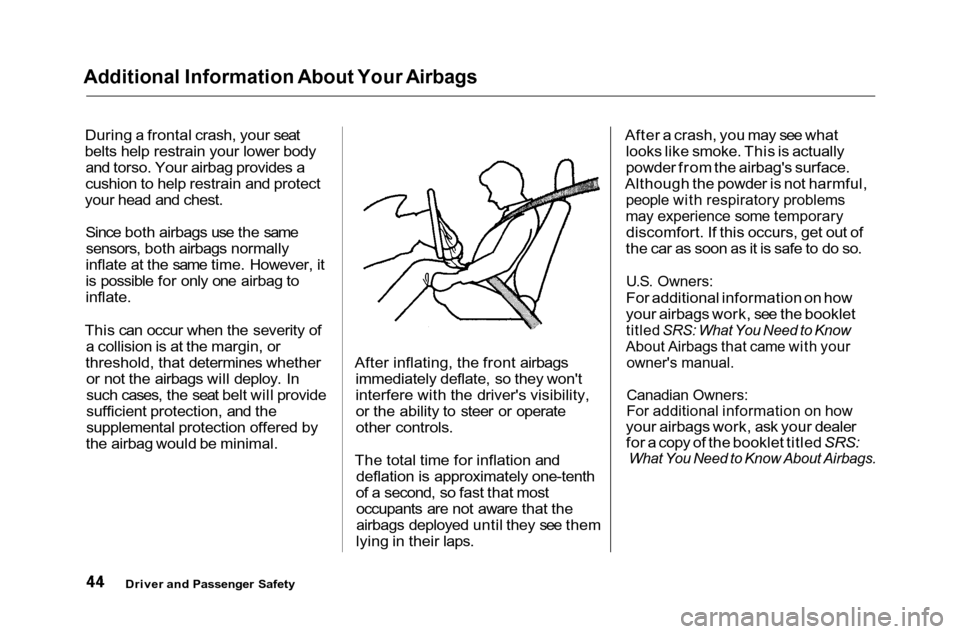
Additional Information About Your Airbags
During a frontal crash, your seat
belts help restrain your lower body and torso. Your airbag provides a
cushion to help restrain and protect
your head and chest.
Since both airbags use the samesensors, both airbags normally
inflate at the same time. However, it
is possible for only one airbag to
inflate.
This can occur when the severity of a collision is at the margin, or
threshold, that determines whether or not the airbags will deploy. In
such cases, the seat belt will provide
sufficient protection, and the
supplemental protection offered by
the airbag would be minimal. After inflating, the front airbags
immediately deflate, so they won't
interfere with the driver's visibility,or the ability to steer or operate
other controls.
The total time for inflation and deflation is approximately one-tenth
of a second, so fast that most occupants are not aware that the
airbags deployed until they see them
lying in their laps. After a crash, you may see what
looks like smoke. This is actually
powder from the airbag's surface.
Although the powder is not harmful,
people with respiratory problems
may experience some temporary
discomfort. If this occurs, get out of
the car as soon as it is safe to do so.
U.S. Owners:
For additional information on how
your airbags work, see the booklet
titled SRS: What You Need to Know
About Airbags that came with your
owner's manual.
Canadian Owners:
For additional information on how
your airbags work, ask your dealer for a copy of the booklet titled SRS:
What You Need to Know About Airbags.
Driver and Passenger Safety
Page 48 of 372
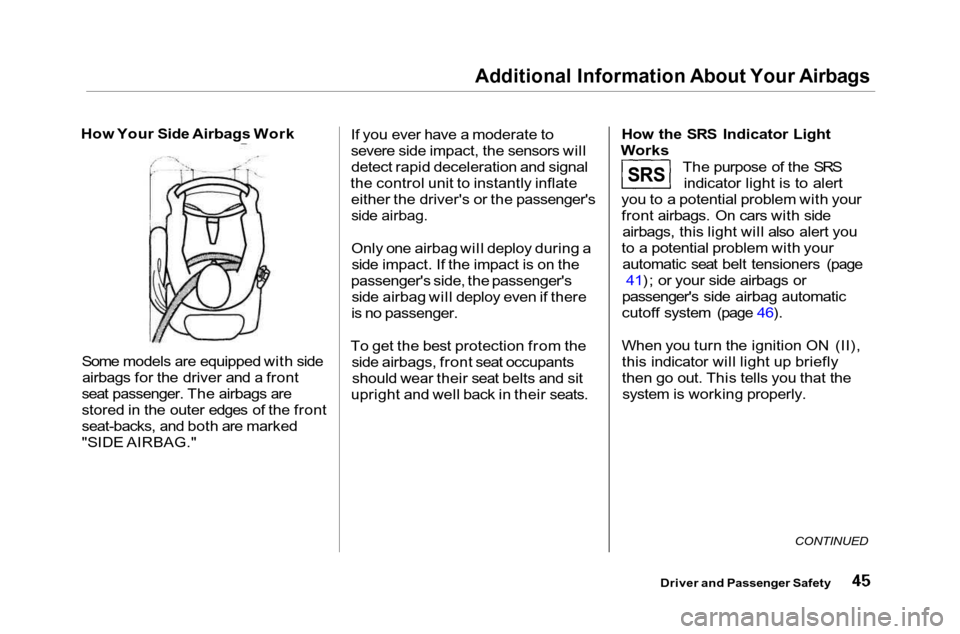
Additional Information About Your Airbags
How Your Side Airbags Work
Some models are equipped with sideairbags for the driver and a front
seat passenger. The airbags are
stored in the outer edges of the front
seat-backs, and both are marked
"SIDE AIRBAG." If you ever have a moderate to
severe side impact, the sensors will
detect rapid deceleration and signal
the control unit to instantly inflate either the driver's or the passenger's
side airbag.
Only one airbag will deploy during aside impact. If the impact is on the
passenger's side, the passenger's side airbag will deploy even if there
is no passenger.
To get the best protection from the side airbags, front seat occupantsshould wear their seat belts and sit
upright and well back in their seats. How the SRS Indicator Light
Works
The purpose of the SRSindicator light is to alert
you to a potential problem with your front airbags. On cars with side airbags, this light will also alert you
to a potential problem with your automatic seat belt tensioners (page 41); or your side airbags or
passenger's side airbag automatic
cutoff system (page 46).
When you turn the ignition ON (II), this indicator will light up briefly
then go out. This tells you that thesystem is working properly.
CONTINUED
Driver and Passenger Safety
SRS
Page 99 of 372
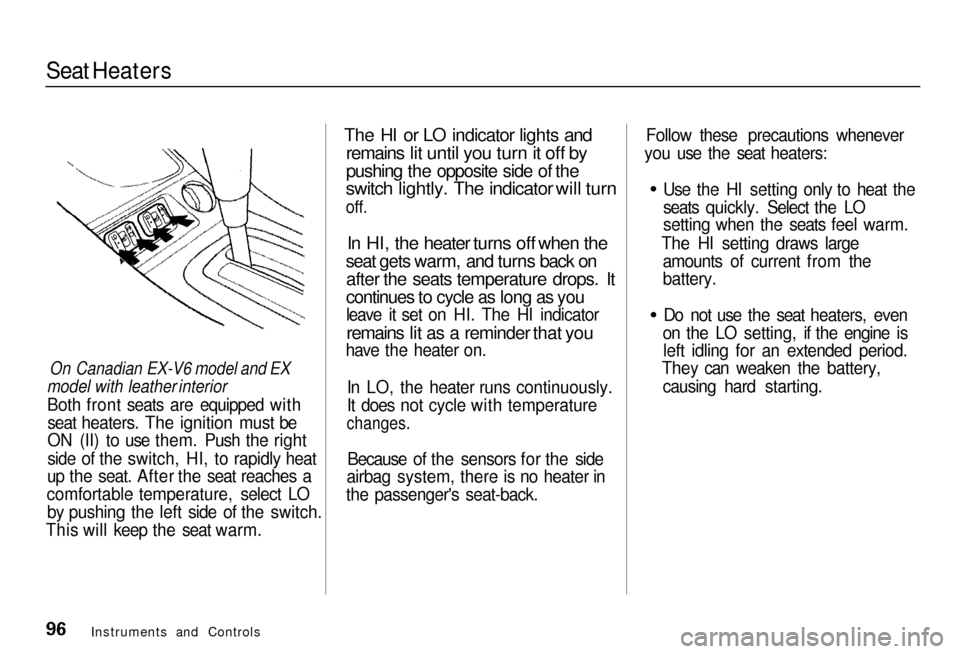
Seat Heaters
On Canadian EX-V6 model and EX
model with leather interior
Both front seats are equipped with
seat heaters. The ignition must be
ON (II) to use them. Push the right
side of the switch, HI, to rapidly heat
up the seat. After the seat reaches a
comfortable temperature, select LO
by pushing the left side of the switch.
This will keep the seat warm.
The HI or LO indicator lights and
remains lit until you turn it off by
pushing the opposite side of the
switch lightly. The indicator will turn
off.
In HI, the heater turns off when the
seat gets warm, and turns back on
after the seats temperature drops. It
continues to cycle as long as you
leave it set on HI. The HI indicator
remains lit as a reminder that you
have the heater on.
In LO, the heater runs continuously.
It does not cycle with temperature
changes.
Because of the sensors for the side
airbag system, there is no heater in
the passenger's seat-back.
Follow these precautions whenever
you use the seat heaters:
Use the HI setting only to heat the
seats quickly. Select the LO
setting when the seats feel warm.
The HI setting draws large
amounts of current from the
battery.
Do not use the seat heaters, even
on the LO setting, if the engine is
left idling for an extended period.
They can weaken the battery,
causing hard starting.
Instruments and Controls
Page 112 of 372
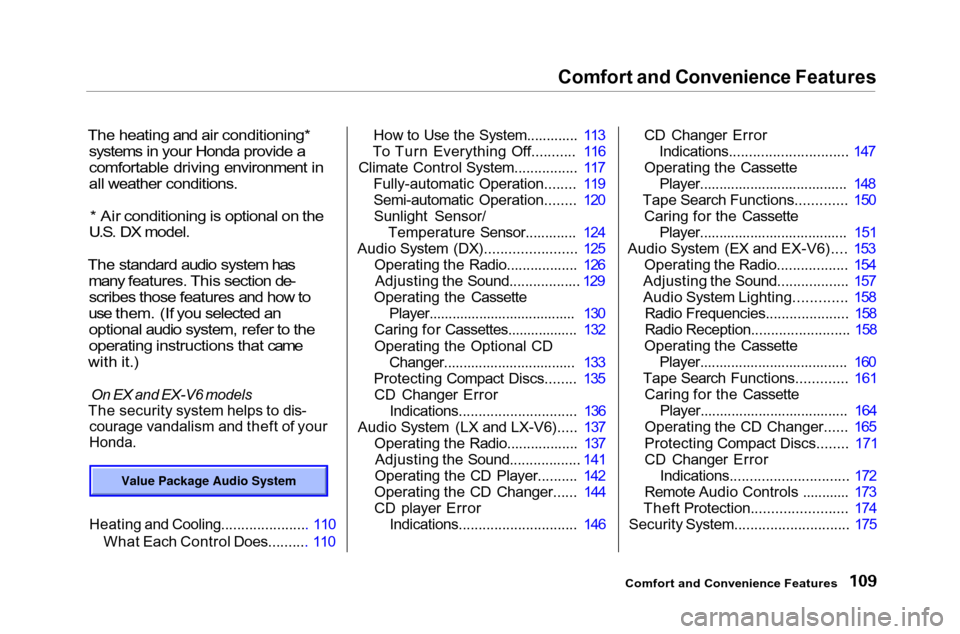
Comfort and Convenience Features
The heating and air conditioning* systems in your Honda provide a
comfortable driving environment in
all weather conditions.
* Air conditioning is optional on the
U.S. DX model.
The standard audio system has many features. This section de-scribes those features and how to
use them. (If you selected an optional audio system, refer to the
operating instructions that came
with it.)
On EX and EX-V6 models
The security system helps to dis- courage vandalism and theft of your
Honda.
Heating and Cooling...................... 110
What Each Control Does.......... 110 How to Use the System............. 113
To Turn Everything Off........... 116
Climate Control System................ 117 Fully-automatic Operation........ 119
Semi-automatic Operation........ 120Sunlight Sensor/ Temperature Sensor............. 124
Audio System (DX)....................... 125 Operating the Radio.................. 126Adjusting the Sound.................. 129
Operating the Cassette Player...................................... 130
Caring for Cassettes.................. 132
Operating the Optional CD Changer.................................. 133
Protecting Compact Discs........ 135 CD Changer Error Indications.............................. 136
Audio System (LX and LX-V6)..... 137 Operating the Radio.................. 137Adjusting the Sound..................
141
Operating the CD Player.......... 142
Operating the CD Changer...... 144
CD player Error Indications.............................. 146 CD Changer Error
Indications.............................. 147
Operating the Cassette Player...................................... 148
Tape Search Functions............. 150 Caring for the Cassette Player...................................... 151
Audio System (EX and EX-V6).... 153 Operating the Radio.................. 154
Adjusting the Sound.................. 157
Audio System Lighting............. 158 Radio Frequencies..................... 158
Radio Reception......................... 158
Operating the Cassette Player...................................... 160
Tape Search Functions............. 161 Caring for the Cassette Player...................................... 164
Operating the CD Changer...... 165
Protecting Compact Discs........ 171
CD Changer Error Indications.............................. 172
Remote Audio Controls ............ 173
Theft Protection........................ 174
Security System............................. 175
Comfort and Convenience Features
Page 127 of 372
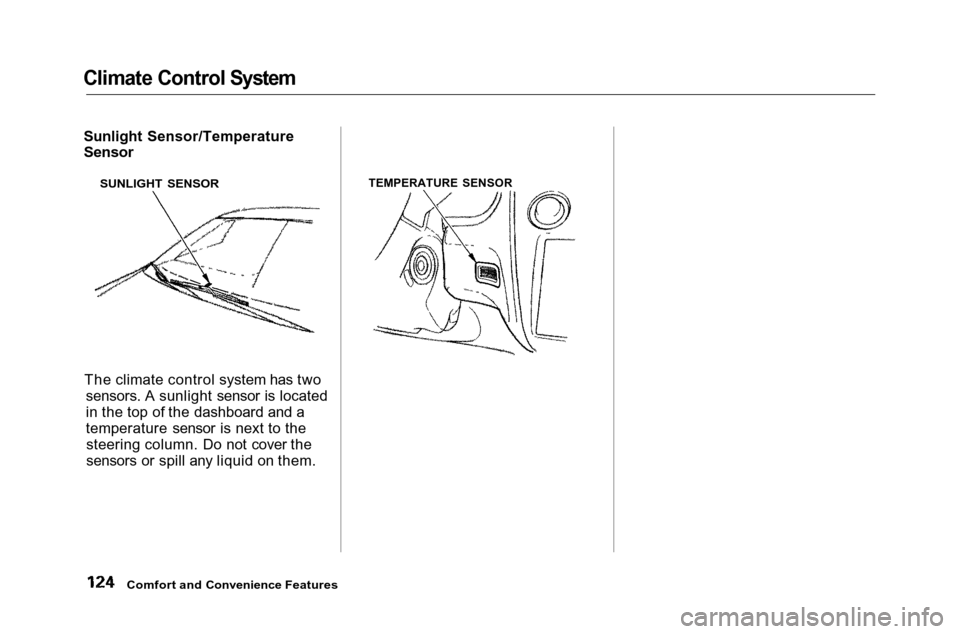
Climate Control System
Sunlight Sensor/Temperature
Sensor
SUNLIGHT
SENSOR
The climate control system has two
sensors. A sunlight sensor is located
in the top of the dashboard and a
temperature sensor is next to thesteering column. Do not cover the
sensors or spill any liquid on them. TEMPERATURE
SENSOR
Comfort and Convenience Features
Page 296 of 372
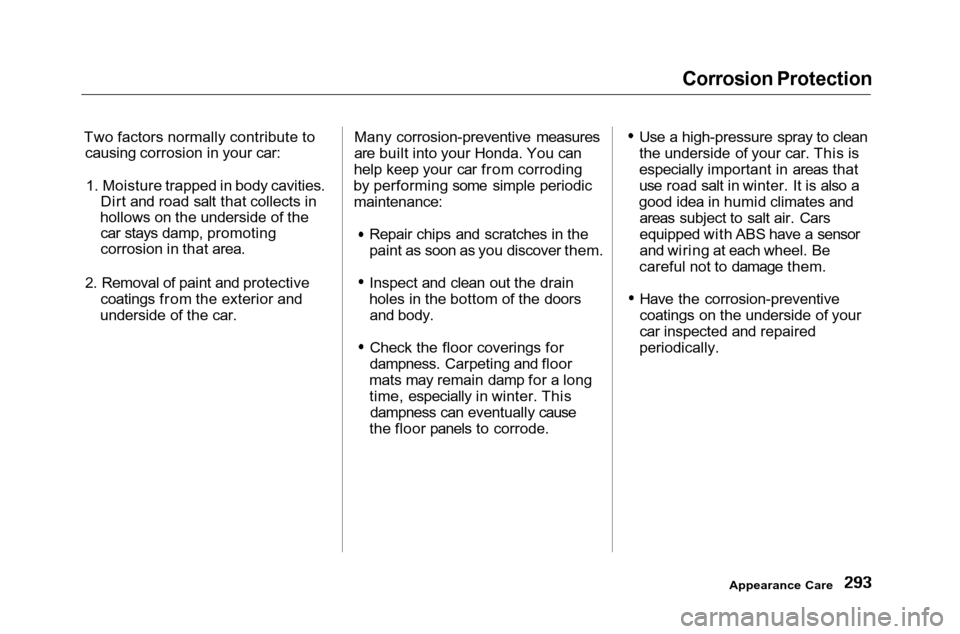
Corrosion Protection
Two factors normally contribute to causing corrosion in your car:
1. Moisture trapped in body cavities. Dirt and road salt that collects in
hollows on the underside of the car stays damp, promoting
corrosion in that area.
2. Removal of paint and protective coatings from the exterior and
underside of the car. Many corrosion-preventive measures
are built into your Honda. You can
help keep your car from corroding
by performing some simple periodic maintenance:
Repair chips and scratches in the
paint as soon as you discover them.
Inspect and clean out the drain
holes in the bottom of the doorsand body.
Check the floor coverings for
dampness. Carpeting and floor
mats may remain damp for a long
time, especially in winter. This dampness can eventually cause
the floor panels to corrode. Use a high-pressure spray to clean
the underside of your car. This is
especially important in areas that
use road salt in winter. It is also a
good idea in humid climates and areas subject to salt air. Cars
equipped with ABS have a sensor
and wiring at each wheel. Be
careful not to damage them.
Have the corrosion-preventive
coatings on the underside of your
car inspected and repaired
periodically.
Appearance Care
Page 335 of 372

Driving in Foreign Countries
If you are planning to take yourHonda outside the U.S. or Canada,
contact the tourist bureaus in the
areas you will be traveling in to find
out about the availability of unleaded
gasoline with the proper octane
rating.
If unleaded gasoline is not available,
be aware that using leaded gasoline in your Honda will affect perfor-mance and fuel mileage, and damage
its emissions controls. It will no
longer comply with U.S. andCanadian emissions regulations, and
will be illegal to operate in North America. To bring your car back into compliance will require the replace-
ment of several components, such as
the oxygen sensors and the three
way catalytic converter. These re- placements are not covered under
warranty.
Technical Information
Page 337 of 372

Emissions Controls
Exhaust Emissions Controls
The exhaust emissions controls include three systems: PGM-FI,Ignition Timing Control and Three
Way Catalytic Converter. These three systems work together tocontrol the engine's combustion and
minimize the amount of HC, CO, and
NOx that comes out the tailpipe. The
exhaust emissions control systemsare separate from the crankcase and
evaporative emissions control
systems.
PGM-FI System
The PGM-FI System uses sequential multiport fuel injection.
It has three subsystems: Air Intake,
Engine Control, and Fuel Control.
The Engine Control Module (ECM) or the Powertrain Control Module (PCM) uses various sensors to
determine how much air is going
into the engine. It then controls how
much fuel to inject under all operat-
ing conditions.
Ignition Timing Control System
This system constantly adjusts the ignition timing, reducing the amountof HC, CO and NOx produced.
Three Way Catalytic Converter
The three way catalytic converter is in the exhaust system. Through
chemical reactions, it converts HC,CO, and NOx in the engine's exhaust
to carbon dioxide (CO 2), dinitrogen
(N2), and water vapor. Replacement Parts
The emissions control systems are
designed and certified to work to-
gether in reducing emissions to
levels that comply with the Clean Air
Act. To make sure the emissions
remain low, you should use only newGenuine Honda replacement parts or
their equivalent for repairs. Using
lower quality parts may increase the emissions from your car.
The emissions control systems are
covered by warranties separate from
the rest of your car. Read your
warranty manual for more informa-
tion.
Technical Information